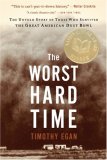Summary | Excerpt | Reviews | Beyond the Book | Readalikes | Genres & Themes | Author Bio
The Untold Story of Those Who Survived the Great American Dust Bowl
by Timothy Egan

Critics' Opinion:
Readers' Opinion:
First Published:
Dec 2005, 320 pages
Paperback:
Sep 2006, 352 pages
 Book Reviewed by:
Book Reviewed by:
BookBrowse Review Team
Buy This Book
A few miles to the southeast, archaeologists were just starting to sort
through a lost village, a place where natives, seven hundred years earlier,
built a small urban complex near the Canadian River, the only reliable running
water in the region. People had lived there for nearly two centuries and left
only a few cryptic clues as to how they survived. When Francisco Vásquez
de Coronado marched through the High Plains in 1541, trailing cattle,
soldiers, and priests in pursuit of precious metals, he found only a handful of
villages along the Arkansas River, the homes made of intertwined grass, and
certainly no cities of gold as he was expecting. His entrada was a bust.
Indians on foot passed through, following bison. Some of Bam White's
distant forefathers — the Querechos, ancestors of the Apache — may have
been among them. The Spanish brought horses, which had the same effect
on the Plains Indian economy as railroads did on Anglo villages in the
Midwest. The tribes grew bigger and more powerful, and were able to travel
vast distances to hunt and trade. For most of the 1700s, the Apache
dominated the Panhandle. Then came the Comanche, the Lords of the
Plains. They migrated out of eastern Wyoming, Shoshone people who had
lived in the upper Platte River drainage. With horses, the Comanche moved
south, hunting and raiding over a huge swath of the southern plains, parts of
present-day Kansas, Colorado, Oklahoma, Texas, and New Mexico. At their
peak in the mid-1700s, they numbered about twenty thousand. To the few
whites who saw them in the days before homesteading, the Comanche
looked like they sprang fully formed from the prairie grass.
"They are the most extraordinary horsemen that I have seen yet in
all my travels," said the artist George Catlin, who accompanied the cavalry on
a reconnaissance mission to the southern plains in 1834.
The Comanche were polygamous, which pleased many a fur
trader adopted into the tribe. Naked, a Comanche woman was a mural unto
herself, with a range of narrative tattoos all over her body. From afar, the
Indians communicated with hand signals, part of a sign language developed
to get around the wind's theft of their shouts. The Comanche bred horses and
mules — the most reliable currency of the 1800s — and traded them with
California-bound gold-seekers and Santa Fe–bound merchants. In between,
they fought Texans. The Comanche hated Texans more than any other group
of people.
Starting around 1840, the Texas Rangers were organized by the
Republic of Texas to go after the Indians. A mounted Comanche was the
most effective warrior of the plains. The Comanche were difficult targets but
even better on offense. Years of hunting bison from horses at full speed gave
them skills that made for an initial advantage over the Rangers. Once
engaged in battle, they charged with a great, rhythmic whoop — like a
football cheer. After a raid and some rest, they would charge again, this time
wearing their stolen booty, even women's dresses and bonnets. They were
proud after killing Texans.
"They made sorrow come into our camps, and we went out like
buffalo bulls when the cows are attacked," said Comanche leader Ten Bears
in 1867. "When we found them we killed them, and their scalps hang in our
lodges. The white women cried, and our women laughed. The Comanches are not weak
and blind like the pups of a dog when seven sleeps old."
The Comanche buried their dead soldiers on a hill, if they could
find one, and then killed the warriors' horses as well. Bison gave them just
about everything they needed: clothes, shelter, tools, and of course a protein
source that could be dried, smoked, and stewed. Some tepees required
twenty bison skins, stretched and stitched together, and weighed 250
pounds, which was light enough to be portable. The animal stomachs were
dried and used as food containers or water holders. Even tendons were put to
good use, as bowstrings. To supplement the diet, there were wild plums,
grapes, and currants growing in spring-fed creases of the .atland, and
antelope, sage grouse, wild turkeys, and prairie chickens, though many
Comanche thought it was unclean to eat a bird.
Copyright © 2005 by Timothy Egan. Reprinted by permission of Houghton Mifflin Company.





The House on Biscayne Bay
by Chanel Cleeton
As death stalks a gothic mansion in Miami, the lives of two women intertwine as the past and present collide.

The Flower Sisters
by Michelle Collins Anderson
From the new Fannie Flagg of the Ozarks, a richly-woven story of family, forgiveness, and reinvention.

The Funeral Cryer by Wenyan Lu
Debut novelist Wenyan Lu brings us this witty yet profound story about one woman's midlife reawakening in contemporary rural China.
Your guide toexceptional books
BookBrowse seeks out and recommends the best in contemporary fiction and nonfiction—books that not only engage and entertain but also deepen our understanding of ourselves and the world around us.